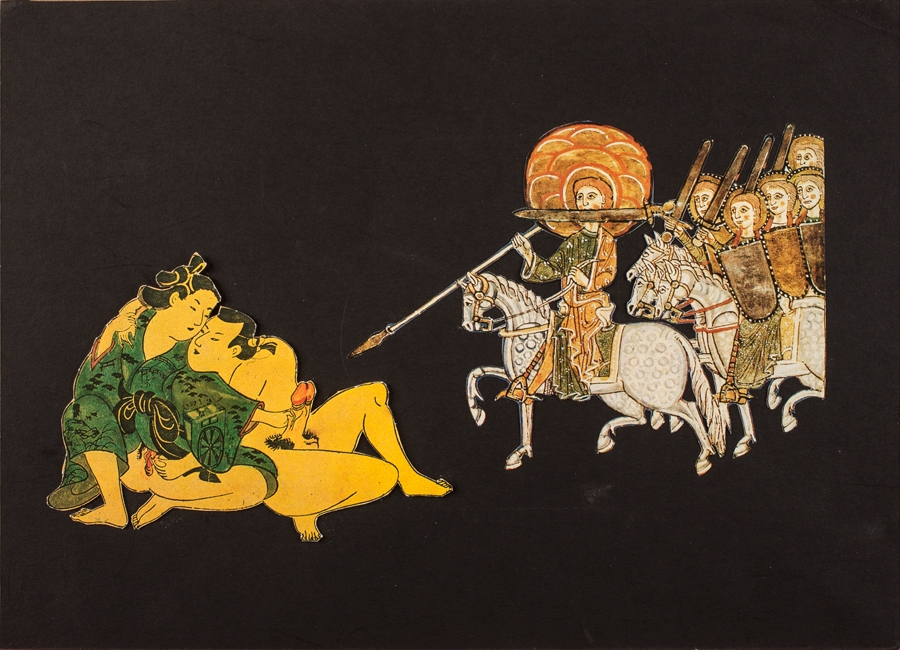Commemorating the donation to the museum in 2014 of 72 drawings by León Ferrari, this exhibition comprises a large complement of the works given by Ferrari’s family, shown along with a selection of prints, sculptures and drawings on loan or from the museum’s existing collection.
Ferrari, who died in 2013 at the age of ninety-two, is perhaps best known for the religious/sacrilegious subject matter that pitted him against Pope Francis, then archbishop of Buenos Aires, over blasphemous works shown in a 2004 retrospective. Some of the same works drew protesters out to picket the São Paulo Bienal in 2014, incensed by a Virgin Mary and Child sculpture swarming with cockroaches, and another being fed into a meat grinder. Here at the MAM, a 2000 statuette of Jesus with a crown of pins is shown alongside works from Ferrari’s Relecturas de la Biblia (Rereadings of the Bible) series, in which canonical images from Western religious art mesh with images and words from other places and times. In an untitled 1987 collage, for example, a Renaissance angel materialises in a mid-twentieth-century photograph to spear a pile of emaciated corpses; and in another, painted mediaeval Crusaders canter grimly, swords drawn, towards a Japanese woodblock print in the shunga style of a couple engaged in enthusiastic, explicit sex.
What shocks most in this exhibition, though, is a series of chilling newspaper clippings Ferrari collected before going into exile in São Paulo in 1976, escaping the violence of Argentina’s vicious military dictatorship. Ferrari used the clippings in 1997 to make the series Nosotros No Sabíamos (We Didn’t Know), in which he printed biblical quotations in Braille (transcribed into Spanish on exhibition labels) over photocopies of selected cuttings. ‘Now go and smite Amalek,’ says the Braille text on Now Go, over one clip reporting the discovery of eight corpses in a parking lot. ‘Utterly destroy all that they have,’ it goes on, ‘and spare them not; but slay both man and woman, infant and suckling’ (1 Samuel 15:3). Simmering with grief and rage when it was created, the work is all the more heartwrenching twenty years on, given the knowledge that Ferrari’s son Ariel was ‘disappeared’ in 1977, having stayed in Buenos Aires when the rest of the family left.
His girlfriend, Liliana Mabel Bietti, returned from Brazil to search for him in the same year and was herself abducted, tortured and never seen again. In Argentina, even language turns against itself: people not only disappear, but ‘are disappeared’; and it’s possible to speculate on whether someone committed suicide or ‘was suicided’ (the term much in vogue there in January this year, when prosecutor Alberto Nisman was found with a bullet through his head on the eve of an appearance before Argentina’s Congress, in which he was to have formally accused President Kirchner of a cover-up over the 1994 bombing of a Jewish centre.)
exquisite gestures cram pages on which the more you look, the more words seem to be straining to make it through the static before being drawn back in, submerged in a babble of lines
Words form an immense part of Ferrari’s oeuvre, appearing occasionally as text, but more often as ciphers of themselves, or as the suggestion of words impossible to utter. Some of the legible examples in this exhibition are in the 1964 ink-on-paper series Manuscripts: ‘Art my son is a beautiful woman who hates to be alone,’ begins one, in curlicued writing reminiscent of that of Ferrari’s Cuadro Escrito (Written Painting) of the same year, not included in this exhibition, which describes the painting the artist would make ‘if I could paint’.
Much of Ferrari’s subsequent work turns on the creation of forms and strokes that come together to look like text but are not text – the tense, neurotic script of a 1976 untitled pastel, for example, impossible to decipher, but readable nonetheless as a score of paranoia and anxiety. Ferrari revisited his scripts again and again over the years, drawing immense canvases of finely wrought, carefully inked curves, Arabic-looking inscriptions and masses of hypnotic scribble, perfectly rhythmical, as in the Errors series of 1991. In pen, ink, watercolour and pencil, exquisite gestures cram pages on which the more you look, the more words seem to be straining to make it through the static before being drawn back in, submerged in a babble of lines. ‘I draw words,’ Ferrari wrote in 1997. ‘Manuscripts, whose strokes are reminiscent of voices… I write drawings about thoughts and images that words cannot express.’ As these drawings demonstrate over and over again, Ferrari achieved an extraordinary eloquence in that endeavour, fusing textlike image and imagelike text in a wordless, soulful articulation, laden with meaning.
To read more by Claire Rigby See here
This article was first published in the March 2015 issue.
